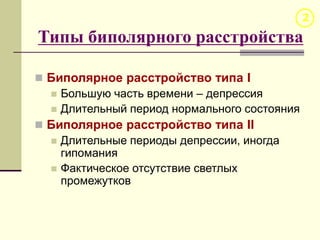Биполярное расстройство типы, Два типа биполярного расстройства

Важно отметить, что биполярное расстройство часто не диагностируется или диагностируется неправильно, и многие люди могут не обращаться за лечением до тех пор, пока у них не возникнет тяжелый эпизод. В чем разница между психотерапевтом, психиатром и психологом? Smulevich AB. Comparative clinical characteristics of depression in bipolar affective disorders types I and II.
Bipolar affective disorder: gender differences in the course and treatment. In Russ. Bipolar affective disorder BAD according to the latest international classifications ICD, DSM-5 is recognized as its own disease, characterized by episodes of mania or hypomania , hyperthymic personality and or a genetic predisposition to BAR in contrast to recurrent depressive disorder RD.
The history of development and classification of manic depressive disorder MDD , difficulties of differential diagnosis between BAD and RD are presented in this literature review.

It considers the clinical features of the course of BAR in men and women and also gender-specific therapy. Gender differences in the clinical picture, course and treatment of BAD are discussed. Attention is drawn to the differences in effectiveness and tolerability of antidepressants in men and women. It is concluded that identifying the gender particularities is important for treatment and prevention optimization. An email was sent to test gmail. Follow the link from the letter to complete the registration on the site.
You can become an author of one of our magazines, send a request and we will consider it in during the day. We use cооkies to improve the performance of the site. By staying on our site, you agree to the terms of use of cооkies. To view our Privacy and Cookie Policy, please. All journals. Очистить поле. Search result: 0.
Views: Downloaded: Contact the author. Table of contents.

To cite this article:. Zhurnal Nevrologii i Psikhiatrii imeni S. Features of the psychoemotional sphere and quality of life of patients with vestibular migraine. Russian Journal of Pain.
Cardiometabolic and psychocognitive features of the post-COVID period in patients with atrial fibrillation. Healy D. Mania: a short history of bipolar disorder. Johns Hopkins University Press. Bleuler E.
Handbook of psychiatry A comparative evaluation of the efficacy of valdoxan agomelatine in recurrent depression and bipolar affective disorder. Zhurnal Nevrologii i Psihiatrii im. Leonhard K. Classification of endogenous psychoses and and their Differentiated Etiology. Angst J, Marneros A. Bipolarity from ancient to modern times: conception, birth and rebirth. J Affect Disord. Dysthymia and cyclothymia in psychiatric practice a century after Kraepelin.
Bipolar affective disorder: diagnosis and therapy. Diagnostic and Statistical Manual of Mental Disorders. American Psychiatric Publishing. National guidelines. Cyclothymic temperamental disorders. Psychiatry Clin North Am. The prevalence of cyclothymia in borderline personality disorder. J Clin Psychiatry.
Tischler GL. Cambridge University Press. World Health Organization. Manual of the international statistical classification of diseases, injuries, and causes of death. Geneva, Switzerland: WHO; Challenges in the management of bipolar depression. Vieta E, Colom F. Psychoeducation manual for bipolar disorder.
Arch Gen Psychiatry. Diagnostic conversion from depression to bipolar disorders: results of a long-term prospective study of hospital admissions. Bipolar affective disorders: the specific features of the course and maintenance pharmacotherapy.
Nevrologiya, Neiropsikhiatriya, Psikhosomatika. To the question about diagnosis of dipolar disorders. Obozrenie Psihiatrii i Med Psihologii. A prospective, longitudinal study of percentage of time spent ill in patients with bipolar 1 or bipolar 2 disorders. Bipolar Disord. Marneros A, Akiskal HS. The overlap of affective and schizophrenic spectra. Gender differences in prevalence, risk, and clinical correlates of alcoholism comorbidity in bipolar disorder.
Am J Psychiatry. Two-year outcomes for interpersonal and social rhythm therapy in individuals with bipolar I disorder.

Bipolar psychopharmacotherapy: caring for the patient. To the question about bipolar affective and anxiety disorders comorbidity. Psihiatriya, Psihoterapiya i Klinicheskaya Psihologiya. Excess mortality in schizophrenia and affective disorders.
Do suicides and accidental deaths solely account for this excess? Kolyagin VV. Bipolar affective disorder. Papadopulos TF. Acute endogenous psychoses psychopathology and classification. Long-term stability of polarity distinctions in the affective disorders. The longitudinal course of recurrent affective illness: life chart data from research patients at the NIMH.
Когда депрессивный эпизод повторяется — это рекуррентное депрессивное расстройство или большое депрессивное расстройство, которое обычно начинается в подростковом или юношеском возрасте. При такого рода депрессии депрессивные фазы, которые могут длиться от несколько месяцев до нескольких лет, чередуются с фазами с нормального настроения. Этот вид депрессивного расстройства может серьёзно затрагивать работоспособность и является однополярным по своей природе нет фазы мании или гипомании.
Это, так называемая «классическая» или «клиническая» депрессия. Дистимия проявляется более мягкими и менее выраженными симптомами, чем депрессивный эпизода или реккурентная депрессия. Тем не менее, расстройство является постоянным, симптомы длятся гораздо дольше, по крайней мере, 2 года, иногда десятилетия, поэтому его называют «хронической депрессией». Это расстройство однополярное, так же влияет на работоспособность.
Этот тип депрессии иногда переходит в более тяжелую форму большой депрессивный эпизод и если это случается, то такое состояние называется двойной депрессией.

Это тип депрессии при биполярном расстройстве, которое ранее называлась маниакально-депрессивный психоз, и встречается реже, чем униполярная депрессии. Она состоит из смены депрессивных фаз, фаз нормального настроения и, так называемых, маниакальных фаз. Маниакальные фазы характеризуются чрезмерно высоким настроением, связанным с гиперактивностью, беспокойством и снижением потребности во сне.
Мания влияет на мышление, рассудительность и социальное поведение вызывает серьезные проблемы и трудности. Когда человек находится в маниакальной фазе, он совершает частые случайные небезопасные половые связи, принимает неразумные финансовые решения.
После маниакального эпизода такие люди часто испытывают депрессию. Лучшим способом описать эти «потрясения эмоций» является фраза "быть на вершине мира и попасть в глубины отчаяния". Симптомы фаз депрессии при биполярном расстройстве иногда трудно отличить от однополярной депрессии. Больше похожа на рекуррентное депрессивное расстройство, чем на биполярное расстройство.
При этом расстройстве множественные депрессивные фазы чередуются с фазами маний, но с менее выраженной эйфорией. Во время этих фаз семья и близкие могут даже ошибочно предполагать, что у человека всё хорошо. При тревожно-депрессивном расстройстве клиника очень похожа на депрессию, однако при депрессии на первое место всегда выходят депрессивные синдромы.
В данном случае равномерно сочетаются как тревожные, так и депрессивные симптомы. Особой формой депрессивного эпизода является психотическая или бредовая депрессия. Существуют различные виды бреда такие как самообвинение без причин бред вины , финансовый крах бред бедности , чувство непонятной болезни ипохондрический бред. Людям с бредовыми депрессиями почти всегда необходимо стационарное психиатрическое лечение.
Психотические эпизоды могут быть как однополярными, так и биполярными.